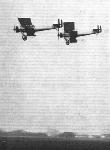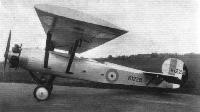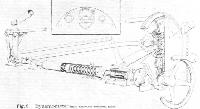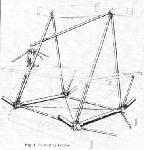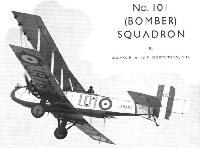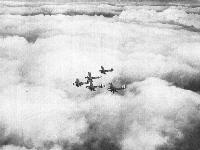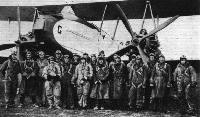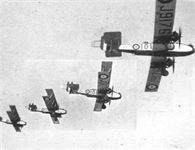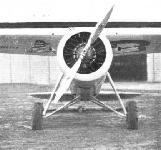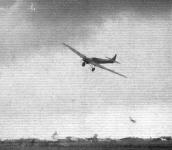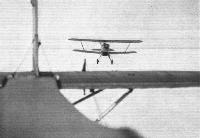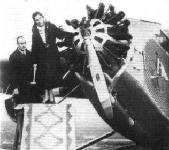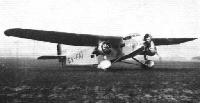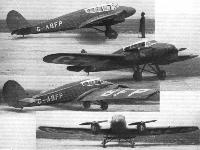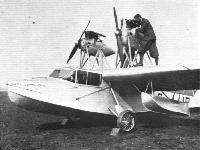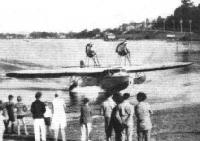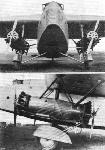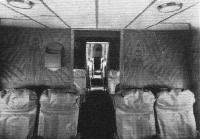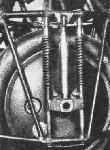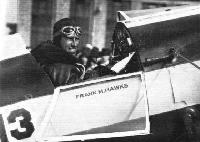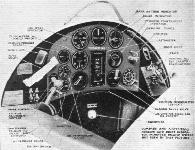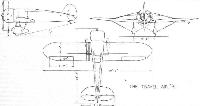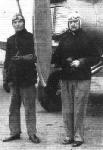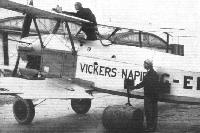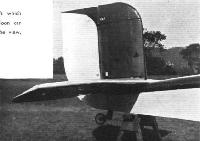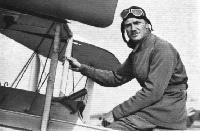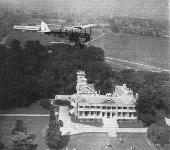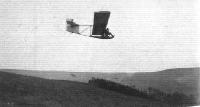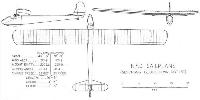Фотографии
-
"BRISTOL" AEROPLANES IN LATVIA: Officers and non-commissioned officers of a "Bulldog" Squadron.
Самолёты на фотографии: Bristol Bulldog - Великобритания - 1927
-
OFF TO IRELAND: Two Vickers "Vespas" with "Jaguar" engines left Weybridge at 12 noon on March 31 and arrived at Sealand at 1 o'clock, having made the journey in exactly one hour. The machines, which are part of an order for the Irish Free State, were piloted by Mr. J. Summers and Captain T. Neville Stack.
Самолёты на фотографии: Vickers Vespa / Type 113 - Великобритания - 1925
-
Регистрационный номер: K1228 [2] Side View of the Parnall Parasol Monoplane. The wing bracing struts are in the form of a deformable parallelogram.
Самолёты на фотографии: Parnall Parasol - Великобритания - 1929
-
Самолёты на фотографии: Parnall Parasol - Великобритания - 1929
-
Регистрационный номер: K1228 [2] THE PARNALL PARASOL MONOPLANE: The wing is raised well clear of the fuselage to avoid interference.
Самолёты на фотографии: Parnall Parasol - Великобритания - 1929
-
Fig.6. Dynamometer
Самолёты на фотографии: Parnall Parasol - Великобритания - 1929
-
Fig.1. Swinging Frame
Самолёты на фотографии: Parnall Parasol - Великобритания - 1929
-
Самолёты на фотографии: Parnall Parasol - Великобритания - 1929
-
Регистрационный номер: J9769 Самолёты на фотографии: Boulton Paul Sidestrand / P.29 - Великобритания - 1926
-
Регистрационный номер: J9768 Р.29 Sidestrand представлял собой типичный равнокрылый биплан.
Three "Sidestrands" of No. 101 (Bomber) Squadron flying in echelon.Самолёты на фотографии: Boulton Paul Sidestrand / P.29 - Великобритания - 1926
-
Five "Sidestrands" of No. 101 (Bomber) Squadron flying in formation above the clouds. Owing to the angle at which the photograph was taken, the aircraft appear to be closer than they really arc. Ample room is left between them so that there shall be no risk of a collision.
Самолёты на фотографии: Boulton Paul Sidestrand / P.29 - Великобритания - 1926
-
Самолёты на фотографии: Boulton Paul Sidestrand / P.29 - Великобритания - 1926
-
Регистрационный номер: J9176, J9178, J9189 Four "Sidestrands" of No. 101 (Bomber) Squadron flying in echelon on the left. This view shows the position of the underneath gun very well, and also the absence of resistance from bomb racks, which are hidden within the contour of the fuselage.
Самолёты на фотографии: Boulton Paul Sidestrand / P.29 - Великобритания - 1926
-
The group shows the officers and airmen of "A" Flight, No. 101 (Bomber) Squadron.
Самолёты на фотографии: Boulton Paul Sidestrand / P.29 - Великобритания - 1926
-
The group shows the officers and airmen of "B" Flight, No. 101 (Bomber) Squadron.
Самолёты на фотографии: Boulton Paul Sidestrand / P.29 - Великобритания - 1926
-
Регистрационный номер: G-ABGK [2] Three-quarter rear view of Lt.-Comdr. Glen Kidston's Lockheed "Vega," which is fitted with a 450-h.p. Pratt and Whitney "Wasp."
Самолёты на фотографии: Lockheed Vega - США - 1927
-
Front view of the Lockheed "Vega" showing the landing chassis and "Wasp" engine.
Самолёты на фотографии: Lockheed Vega - США - 1927
-
The neat landing chassis (Goodyear tyres) and the N.A.C.A. cowling of the Lockheed "Vega."
Самолёты на фотографии: Lockheed Vega - США - 1927
-
Регистрационный номер: G-ABGK [2] This side view of the Lockheed "Vega" shows the exceptionally clean lines of this machine.
Самолёты на фотографии: Lockheed Vega - США - 1927
-
Самолёты на фотографии: Dewoitine D.33 - Франция - 1931
-
Our illustration shows the Dewoitine D.33 Monoplane (650 h .p. Hispano Suiza) on which the new records were made.
Самолёты на фотографии: Dewoitine D.33 - Франция - 1931
-
"FIERY" PERFORMANCE: Mr. Staniland demonstrating, in no uncertain manner, the terrific performance of the Fairey Firefly II at Hanworth before the Japanese Prince and Princess Takamatsu.
Самолёты на фотографии: Fairey Firefly - Великобритания - 1925
-
THE INTERCEPTOR FIGHTER: A Photographic Impression of a Hawker "Fury" with Rolls Royce engine above the clouds.
Самолёты на фотографии: Hawker Fury - Великобритания - 1931
-
Регистрационный номер: K1926 The latest production type of Hawker "Fury" (Rolls-Royce "Kestrel" engine), the Interceptor Fighter ordered for No. 43 (Fighter) Squadron. In the photograph it looks curiously as if the "Fury" was about to alight on the tail of H.M. Aircraft Carrier "Horsley." This photograph was obtained above the clouds recently, from a Hawker "Horsley." The two machines were piloted by Mr. Bulman and Mr. Saver respectively.
Самолёты на фотографии: Hawker Fury - Великобритания - 1931Hawker Horsley / Dantorp - Великобритания - 1925
-
Регистрационный номер: CF-AGO CANADA'S GOODWILL AEROPLANES: This D.H. "Puss Moth" recently completed a trans-Canada tour which was undertaken to stimulate interest in aviation. The names of the towns visited are stencilled on the side of the fuselage, some of which are :- Toronto, Ottawa, St. Hubert, London, Camp Borden, Detroit (Mich.), Chicago (Ill.), Madison (Wis.), St. Paul (Minn.), Fargo, Winnipeg, Regina, Moose Jaw, Calgary, Cranbrook (B.C.), Vancouver, Edmonton, Saskatoon, Stratford, Hamilton, Niagara Falls, etc., etc. This picture was taken at Limberlost Lodge, a winter resort near Toronto, Ontario, with some of the visitors who made a trip in the machine.
Самолёты на фотографии: De Havilland Puss Moth / D.H.80 - Великобритания - 1929
-
EDUCATING THE YOUNG IDEA: At the Schoolboys' Exhibition in January last, Henlys, the Avian Agents, instituted an essay competition with free flights as the prizes. The 50 winners were given their flights at Heston on Wednesday and Thursday, April 8 and 9. The broad gentleman on the left is Mr. J. Holman, the Sales Manager of the Cirrus-Hermes Engineering Co., Ltd., who took up many of the boys in the Company's Avian (Hermes) in front of which they are standing. On the right are Mr. B. S. Allen, Henly's Aviation representative and his assistant, Mr. Stace, who of course also used Avians for this work.
Самолёты на фотографии: Avro Avian / Type 594/616 - Великобритания - 1926
-
"COMTE DE LA VAULX": Princess Bibesco christens the Ford monoplane on which Prince Bibesco is making a tour of the aerodromes of Europe and Asia.
Самолёты на фотографии: Ford Tri-Motor / 4-AT / 5-AT - США - 1926
-
Регистрационный номер: CV-FAI The Ford monoplane on which Prince Bibesco is making a tour of the aerodromes of Europe and Asia.
Самолёты на фотографии: Ford Tri-Motor / 4-AT / 5-AT - США - 1926
-
Регистрационный номер: G-ABFP THE METAL "METEOR": G-ABFP is the first of these, and belongs to Mr. Selfridge, Jun. With other machines from Heston the "Meteor" is making a tour to Spain during the Easter Holidays.
Самолёты на фотографии: Blackburn Segrave Meteor / B-1 - Великобритания - 1930
-
Регистрационный номер: G-AAIP A Saro "Cutty Sark" ready to leave Heston on a tour towards Greece, with Lord Lymington, Capt. Balfour, and Flt.-Lt. Pope.
Самолёты на фотографии: Saunders-Roe Cutty Sark / A.17 - Великобритания - 1929
-
THE "CUTTY SARK" IN TASMANIA: The Matthews Aviation Saro "Cutty Sark" amphibian arriving at Hobart after a flight from Australia on December 18 last.
Самолёты на фотографии: Saunders-Roe Cutty Sark / A.17 - Великобритания - 1929
-
Front and side views of the engine installation of the Fokker F.32. The engines are Pratt 8C Whitney, 575-h.p. "Hornet B" radials.
Самолёты на фотографии: Fokker/Atlantic F.32 - США - 1929
-
A view of the cabin in the Fokker F.32.
Самолёты на фотографии: Fokker/Atlantic F.32 - США - 1929
-
A view of the cabin in the Fokker F.32.
Самолёты на фотографии: Fokker/Atlantic F.32 - США - 1929
-
Plan, front and side views of the Fokker F.32.
Самолёты на фотографии: Fokker/Atlantic F.32 - США - 1929
-
A CZECHOSLOVAK MILITARY BIPLANE: The S.316 which is fitted with a "Praga Es" 550-h.p. engine.
Самолёты на фотографии: Letov S-16 - Чехословакия - 1926
-
Регистрационный номер: NR1313 [5] U.S. SPEED KING IN EUROPE: Capt. Frank M. Hawkes, the well-known American cross-country pilot, and his "mystery" monoplane, the Texaco 13 Travel Air, are now in Europe, record hunting. On April 6 he flew from Cherbourg to Le Bourget in 54 minutes, at a speed of 228 m.p.h. - a record for the trip.
Самолёты на фотографии: Travel Air Type R Mystery Ship - США - 1929
-
Регистрационный номер: NR1313 [5] Capt. Frank Hawks arriving at Croydon.
Самолёты на фотографии: Travel Air Type R Mystery Ship - США - 1929
-
Регистрационный номер: NR1313 [5] This view emphasises the cleanliness of the undercarriage, though many designers may not agree that wires in such a case produce less drag than a strut would.
Самолёты на фотографии: Travel Air Type R Mystery Ship - США - 1929
-
The self-contained oleo-cum-spring shock-absorbing mechanism for each wheel is understood easily from this illustration.
Самолёты на фотографии: Travel Air Type R Mystery Ship - США - 1929
-
The Venturi engine cowling, which it can be seen consists of two distinct portions, is made of 20 G. aluminium sheet and plays an important part in decreasing the drag of the fuselage.
Самолёты на фотографии: Travel Air Type R Mystery Ship - США - 1929
-
Регистрационный номер: NR1313 [5] Capt. Hawks in his cockpit. The action of the sliding wind screen is plainly visible.
Самолёты на фотографии: Travel Air Type R Mystery Ship - США - 1929
-
Регистрационный номер: NR1313 [5] The Texaco No. 13 is used as a flying laboratory and consequently many special instruments have been fitted.
Самолёты на фотографии: Travel Air Type R Mystery Ship - США - 1929
-
The Travel Air "R"
Самолёты на фотографии: Travel Air Type R Mystery Ship - США - 1929
-
Регистрационный номер: G-ABFB THE SECOND "KENT": Number 2 of the three four-engined flying boats built by Short Bros, for Imperial Airways has now been launched, and was paraded at Rochester early this week. The first machine of the "Kent" class was, it may be remembered, christened "Scipio." This second machine is named "Sylvanus," and the third, which is all but finished, will be named "Satyrus." The registration letters assigned to the three machines are: G-ABFA, G-ABFB and G-ABFC respectively. In this picture "Sylvanus" is seen at its buoy, starting the Bristol "Jupiter" engines.
Самолёты на фотографии: Short Kent / S.17 - Великобритания - 1931
-
125 IN THE AIR: Among tho most unusual aeroplanes at the Paris Show last year was the Bleriot 125, a twin-fuselage, 2-engined monoplane, fitted with two 500-h.p. Hispano-Suiza engines in tandem. The machine carries 12 passengers, 1,200 lb. of luggage, and fuel for 6 hours at cruising speed. The wheels, of the Bleriot resilient type, are partly housed in the fuselage, and are fitted with Palmer brakes.
Самолёты на фотографии: Bleriot Bleriot-125 - Франция - 1931
-
Самолёты на фотографии: Vickers Vixen / Venture / Valparaiso / Valiant - Великобритания - 1923
-
Самолёты на фотографии: Vickers Vixen / Venture / Valparaiso / Valiant - Великобритания - 1923
-
Самолёты на фотографии: Vickers Vixen / Venture / Valparaiso / Valiant - Великобритания - 1923
-
Регистрационный номер: G-ABFJ [3] Самолёты на фотографии: Civilian (CAC) Coupe - Великобритания - 1929
-
A MODERN TAIL: The tail wheel shows the thoroughly practical way in which the Civilian Coupe has been designed as regards such details. This fitting makes the Coupe very comfortable when taxying.
Самолёты на фотографии: Civilian (CAC) Coupe - Великобритания - 1929
-
Регистрационный номер: G-ABFJ [3] Самолёты на фотографии: Civilian (CAC) Coupe - Великобритания - 1929
-
Регистрационный номер: G-ABFJ [3] Самолёты на фотографии: Civilian (CAC) Coupe - Великобритания - 1929
-
Регистрационный номер: G-ABFW EN ROUTE FOR PERSIA: Mrs. Edwin Montague sets out for Persia in her Gipsy Moth, piloted by Mr. Rupert Belville. On the right, some friends, including Lady Diana Cooper, bid the travellers good-bye.
Самолёты на фотографии: De Havilland Gipsy Moth / Moth X - Великобритания - 1928
-
Регистрационный номер: G-ABHY [2] Mr. C. W. A. Scott, who flew to Australia in 9 1/2 days, has served in the R.A.F., and as pilot with Q.A.N.T.A.S., in Australia.
Самолёты на фотографии: De Havilland Gipsy Moth / Moth X - Великобритания - 1928
-
HANWORTH CLUB: The central N.F.S. Workshop, together with the "Grange," where the head office is now housed, can be seen on the far side of the aerodrome behind the tail of the club Moth (Cirrus III). The wonderful old club-house, with its well-kept lawns and gardens, is best seen from the air.
Самолёты на фотографии: De Havilland Gipsy Moth / Moth X - Великобритания - 1928
-
Регистрационный номер: HK906 The five Gipsy Moths of the Iraq Flying Corps which left Hatfield aerodrome on Wednesday, April 8, to fly to Baghdad. They are shown on the ground and flying in formation.
Самолёты на фотографии: De Havilland Gipsy Moth / Moth X - Великобритания - 1928
-
Регистрационный номер: G-ABHY [2] Mr. Scott's De Havilland "Moth," with "Gipsy II" engine, which made its first trials early in March. It had special fuel tanks, having a capacity of 101 gals.
Самолёты на фотографии: De Havilland Gipsy Moth / Moth X - Великобритания - 1928
-
The Dickson glider built by the Aircraft Club, Harrogate.
Самолёты на фотографии: Lippisch / RRG Zogling - Германия - 1926
-
Регистрационный номер: G-AAVT An aerial view of the Hendy 302 [Hermes II) flying over the Sussex Downs. This machine is the fastest cabin light aircraft available for private owners and cruises at 125 m.p.h. Built by the Hendy Aircraft Co., of Shoreham-by-Sea, Sussex, this is an extremely fascinating aircraft.
Самолёты на фотографии: Hendy Hendy 302 - Великобритания - 1929
-
A Waco primary type glider being towed by an outboard motor-boat. A new form of providing thrills in America.
Самолёты на фотографии: WACO Primary glider - США - 1930
-
Rear view of the "Privateer" before the start of the flight from St. Hubert to St. Agathe in wintry conditions.
Самолёты на фотографии: Ireland / Amphibions Privateer - США - 1931
-
The "Privateer" in front of the big Government hangar at St. Hubert Airport, Montreal. Captain Ted Cooper and Captain Chambers, respectively pilot and owner of the machine, are in front of it, and the other begoggled figure is the Hon. Athanase David, Provincial Secretary of Quebec, who was the first official passenger when he chartered the machine to fly him to his home at Ste. Agathe, where the landing was made on deep snow.
Самолёты на фотографии: Ireland / Amphibions Privateer - США - 1931
-
Регистрационный номер: NC93K These three views - on the water, taking off from land, and flying - give a good idea of the unusual features of the "Privateer" amphibian.
Самолёты на фотографии: Ireland / Amphibions Privateer - США - 1931
-
The R.F.D. Sailplane has been designed by Mr. R. P. Bewsher and has a wide and a narrow centre section, so that interchanging them produces either a sailplane or a secondary glider.
Самолёты на фотографии: RFD (Dagnall, Bewsher) RFD-2 - Великобритания - 1931
-
Front view of the Bernard type 80 G.R., Monoplane, fitted with a 650 h.p. Hispano-Suiza engine.
Самолёты на фотографии: Bernard Bernard 80 GR - Франция - 1930
-
Three-quarter rear view of the Bernard type 80 G.R., Monoplane, fitted with a 650 h.p. Hispano-Suiza engine.
Самолёты на фотографии: Bernard Bernard 80 GR - Франция - 1930
-
Самолёты на фотографии: Stout SkyCar - США - 1931
-
THE STOUT SKY CAR": Three-quarter front view from above. Lateral control is by pivoted wing tips, instead of by ailerons.
Самолёты на фотографии: Stout SkyCar - США - 1931
-
Front view of the Bloudek monoplane. Note the air scoop in the engine cowling,
Самолёты на фотографии: Bloudek XV Lojze - Югославия - 1930
-
JUGO-SLAV LIGHT 'PLANE: The Bloudek XV low-wing monoplane, which is fitted with a "Cirrus II" engine.
Самолёты на фотографии: Bloudek XV Lojze - Югославия - 1930
-
Регистрационный номер: X951Y AN UNUSUAL DESIGN: Successful tests are stated to have been made at California with this strange-looking craft, designed by Earl E. McClary, of Huntington Park, Los Angeles, who is seen standing beside the machine. It is said to possess remarkable controllability at very low speeds. Except that it has a 75-h.p. engine, particulars of this machine are not yet available.
Самолёты на фотографии: McClary pusher - США - 1931
Статьи
- Flight

